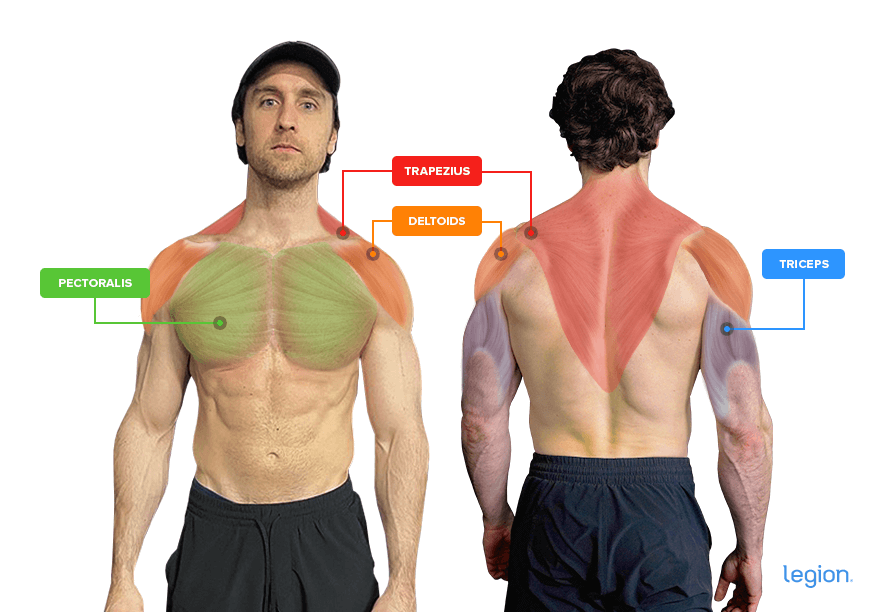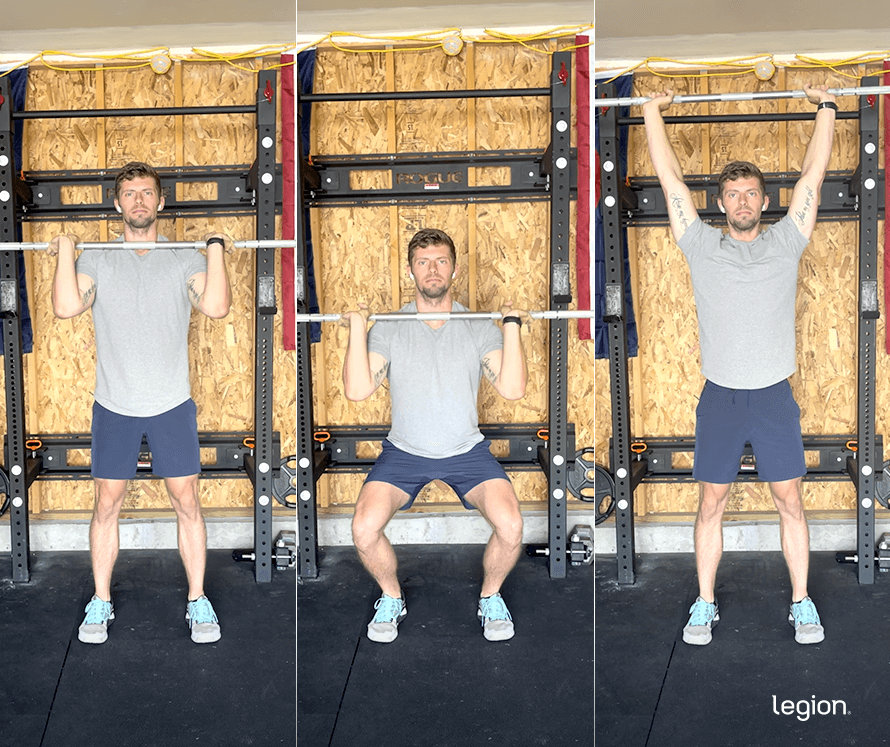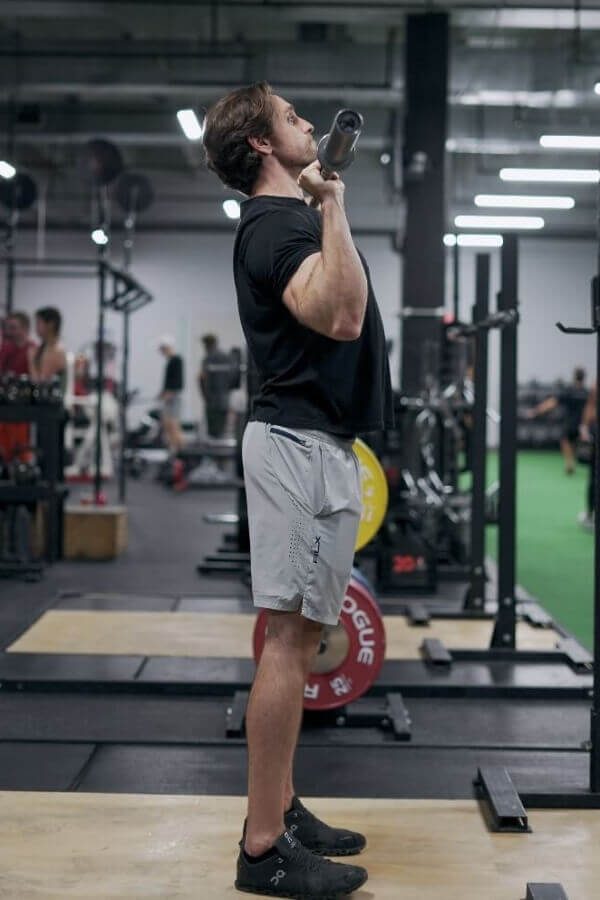The push press is an overhead pressing exercise that uses your lower body to generate momentum and help move the bar upward.
Most weightlifters can benefit from the push press because it trains several major muscle groups across your entire body and is an excellent way to boost your overhead pressing strength.
It’s especially valuable for athletes because it also helps you develop full-body power, which is important for sports that require explosive movements, such as sprinting, jumping, and throwing
In this article, you’ll learn what the push press is, its benefits, which muscles it works, how to perform the push press with proper form, the best push press alternatives, and more.
What Is the Push Press?
The push press is an overhead press that begins with a quarter squat. You use the momentum generated as you rise from the squat to help you press the bar upward until your arms are locked overhead.
This doesn’t mean it’s a sloppy overhead press (as some erroneously think).
The point of the push press is to generate just enough momentum to help get the bar off your shoulders and through the first few inches of the press, where it’s most likely to get stuck. From there, your shoulders and arms do all the work.
This allows you to use heavier weights than with the standing overhead press without reducing range of motion much.
Push Press vs. Overhead Press: Which Is Better?
It depends.
The overhead press requires less coordination and athleticism than the push press, which makes it an easier starting point for new weightlifters. It’s also a better measure of upper-body strength since you can’t rely on a strong lower body to boost your pressing numbers.
On the other hand, the push press trains more muscle groups across your entire body and allows you to lift heavier weights than you can overhead press. This is significant for two reasons:
- It makes your training more efficient (one exercise can do the work of several).
- It allows you to train your shoulders with more weight than you can press with “strict” form, which is generally better for muscle and strength gain and can help if your overhead press progress stalls.
The downside, however, is that the push press is a more technical exercise than the overhead press, which some weightlifters find off-putting.
In other words, they both have merits, which is why it’s often beneficial to include both exercises in your program.
A good way to do this is to include the overhead press in your program for 8-to-10 weeks of training, take a deload, then replace the overhead press with the push press for the following 8-to-10 weeks of training.
Then, you can either continue alternating between the exercises every few months or stick with the one you prefer.
This is how I personally like to organize my training, and it’s similar to the method I advocate in my fitness book for intermediate and advanced weightlifters, Beyond Bigger Leaner Stronger.
(If you aren’t sure if Beyond Bigger Leaner Stronger is right for you or if another strength training program might be a better fit for your circumstances and goals, take the Legion Strength Training Quiz, and in less than a minute, you’ll know the perfect strength training program for you. Click here to check it out.)
Push Press: Benefits
1. It improves your athletic performance.
Strength and power are different.
Strength refers to your ability to generate maximum force to overcome resistance. Conversely, power refers to your ability to generate force quickly. Power is strength plus speed, basically.
Few sports require exceptional strength (powerlifting being an obvious exception), though most require power (to sprint, jump, tackle, throw, punch, kick, and so forth).
Research shows that the push press is particularly beneficial in this regard because it involves lifting weights explosively, which helps you develop full-body power that can improve your performance on the field, track, or court.
Unlike many pressing exercises, the push press is also a closed-kinetic-chain exercise, an exercise where your hands or feet are fixed on a stationary object (in this case, the floor).
Experts generally agree that closed-kinetic-chain exercises are better at boosting sports performance than open-kinetic-chain exercises because they help you develop greater balance and stability, more closely mimic the type of movements involved in sports, and train more “stabilizer” muscles across your entire body.
2. It improves your overhead press.
Most people fail the overhead press as the bar reaches their forehead because it’s here that your body is in an inherently weak position (your elbows aren’t stacked over your shoulders and your wrists aren’t stacked over your elbows).
The push press helps you gain strength in this range of motion by allowing you to train with heavier weights than you can overhead press, which should carry over when you go back to strict pressing.
The push press also forces you to control heavier-than-normal weights during the eccentric (lowering) phase of the exercise. This is significant because research shows that doing heavy eccentric exercise is effective for gaining muscle and strength and improving athletic performance.
3. It trains several muscle groups simultaneously.
Many people think of the push press as a shoulder exercise.
While it’s true that the push press trains all three heads of the deltoids to a high degree, it also effectively trains several other major muscle groups across your entire body, including your upper and lower back, abs, forearms, glutes, quads, pecs, and triceps.
Push Press: Muscles Worked
The main muscles worked by the push press are the . . .
- Deltoids
- Trapezius
- Triceps
- Pectoralis major and minor
It also trains your mid and lower back, abs, forearms, quads, and glutes to a lesser degree, too.
Here’s what the main muscles worked in the push press look like on your body:

How to Do the Push Press
The best way to learn how to do the push press is to split the exercise into four parts: set up, dip, press, and descend.

Model: Ryan Koziol
1. Set up
Adjust the hooks in a power rack or squat rack so the bar is around the height of your collarbone like this:

Face the bar and grip it with your palms facing forward and thumbs wrapped around the bar, slightly wider than shoulder-width.
With the bar in your hands, bend your knees slightly and lean forward, positioning the bar on top of your shoulders and upper chest. Stand up, lifting the bar off the rack, and take one step back with each foot.
Here’s how it should look:

Adjust your feet so they’re about hip-width apart and point your toes out about 20-to-25 degrees (around one and eleven o’clock).
2. Dip
Take a deep breath into your stomach and arch your upper back enough so the bar is directly over your midfoot and your head is slightly behind the bar.
Drop your butt 3-to-6 inches by bending your knees and allowing them to travel forward in the same direction as your feet, then shoot your hips upward and extend your knees as explosively as possible.
3. Press
Once you reach the top of the squat, use the momentum generated by your lower body and press the bar straight up. As the bar passes your eyes, push your head and chest forward and under the bar.
Keep pushing the bar toward the ceiling until your arms are straight.
4. Descend
Reverse the movement and return the barbell to its starting position on top of your shoulders and upper chest. Bend your knees again to “catch” the bar as it descends if you prefer.
Don’t let the barbell fall back to the starting position or try to lower it slowly—the entire descent should be controlled but take less than a second.
The Best Push Press Alternatives
1. Dumbbell Push Press
The dumbbell push press (or “DB push press”) confers many of the same benefits as the barbell push press. The difference is that in the dumbbell push press, you use dumbbells instead of a barbell.
Using dumbbells is beneficial because it trains each side of your body independently, which helps you identify and even out any muscle and strength imbalances you might have. It also allows you to move your shoulders, arms, and wrists more freely, which some people find more comfortable.
However, you typically can’t lift as much weight when you use dumbbells, which limits the muscle- and strength-building potential of the exercise.
2. Kettlebell Push Press
Similarly to the dumbbell push press, the kettlebell push press (or “KB push press”) trains each side of your body independently and allows you to move more freely than when you use a barbell, which helps you avoid and correct muscle and strength imbalances and may feel more comfortable.
This makes the kettlebell push press a viable alternative to the dumbbell push press.
3. Single-Arm Push Press
In the single-arm push press, you train one side of your body at a time. This forces your core to work harder to stabilize your torso, making it a better ab and core exercise than the regular push press. Using one arm at a time also reduces how much weight you can press, so the single-arm push press isn’t as effective at helping you gain muscle and strength as other push-press variations.
4. Snatch-Grip Push Press
In the snatch-grip push press, you grip the barbell about twice as wide as on the regular push press. People mainly perform the push press with a “snatch grip” to improve their performance on Olympic weightlifting exercises, particularly the snatch.
Unless your goal is to improve your snatch performance, using a different push press variation is probably sensible. That’s because adopting a snatch grip requires a degree of shoulder mobility most people lack, and it significantly reduces how much weight you can lift, which means it’s not as effective as other variations for gaining muscle and strength.
5. Landmine Push Press
In the landmine push press, one end of the barbell is anchored in a landmine attachment. This means the bar travels in an arc as you dip and press, which some people find more comfortable and stable than using free weights.
The Best Push Press Workout
Here’s a workout that includes all the best exercises for training your “pushing” muscles, including the push press:
- Push Press: 3 sets of 4-to-6 reps with 2-to-3 min rest
- Incline Dumbbell Bench Press: 3 sets of 4-to-6 reps with 2-to-3 min rest
- Dumbbell Side Lateral Raise: 3 sets of 6-to-8 reps with 2-to-3 min rest
- Overhead Triceps Extension: 3 sets of 6-to-8 reps with 2-to-3 min rest
(And if you’d like even more specific advice about what exercises to include in your training program to reach your health and fitness goals, take the Legion Strength Training Quiz, and in less than a minute, you’ll know the perfect strength training program for you. Click here to check it out.)
Scientific References +
- Lake, J. P., Mundy, P. D., & Comfort, P. (2014). Power and impulse applied during push press exercise. Journal of Strength and Conditioning Research, 28(9), 2552–2559. https://doi.org/10.1519/JSC.0000000000000438
- Loturco, I., Kobal, R., Maldonado, T., Piazzi, A. F., Bottino, A., Kitamura, K., Abad, C. C. C., Pereira, L. A., & Nakamura, F. Y. (2017). Jump Squat is More Related to Sprinting and Jumping Abilities than Olympic Push Press. International Journal of Sports Medicine, 38(8), 604–612. https://doi.org/10.1055/S-0035-1565201
- Soriano, M. A., Suchomel, T. J., & Comfort, P. (2019). Weightlifting Overhead Pressing Derivatives: A Review of the Literature. Sports Medicine (Auckland, N.Z.), 49(6), 867. https://doi.org/10.1007/S40279-019-01096-8
- Kwon, Y. J., Park, S. J., Jefferson, J., & Kim, K. (2013). The Effect of Open and Closed Kinetic Chain Exercises on Dynamic Balance Ability of Normal Healthy Adults. Journal of Physical Therapy Science, 25(6), 671. https://doi.org/10.1589/JPTS.25.671
- Kim, M. K., & Yoo, K. T. (2017). The effects of open and closed kinetic chain exercises on the static and dynamic balance of the ankle joints in young healthy women. Journal of Physical Therapy Science, 29(5), 845–850. https://doi.org/10.1589/JPTS.29.845
- Schoenfeld, B. J., Ogborn, D. I., Vigotsky, A. D., Franchi, M. V., & Krieger, J. W. (2017). Hypertrophic Effects of Concentric vs. Eccentric Muscle Actions: A Systematic Review and Meta-analysis. Journal of Strength and Conditioning Research, 31(9), 2599–2608. https://doi.org/10.1519/JSC.0000000000001983










